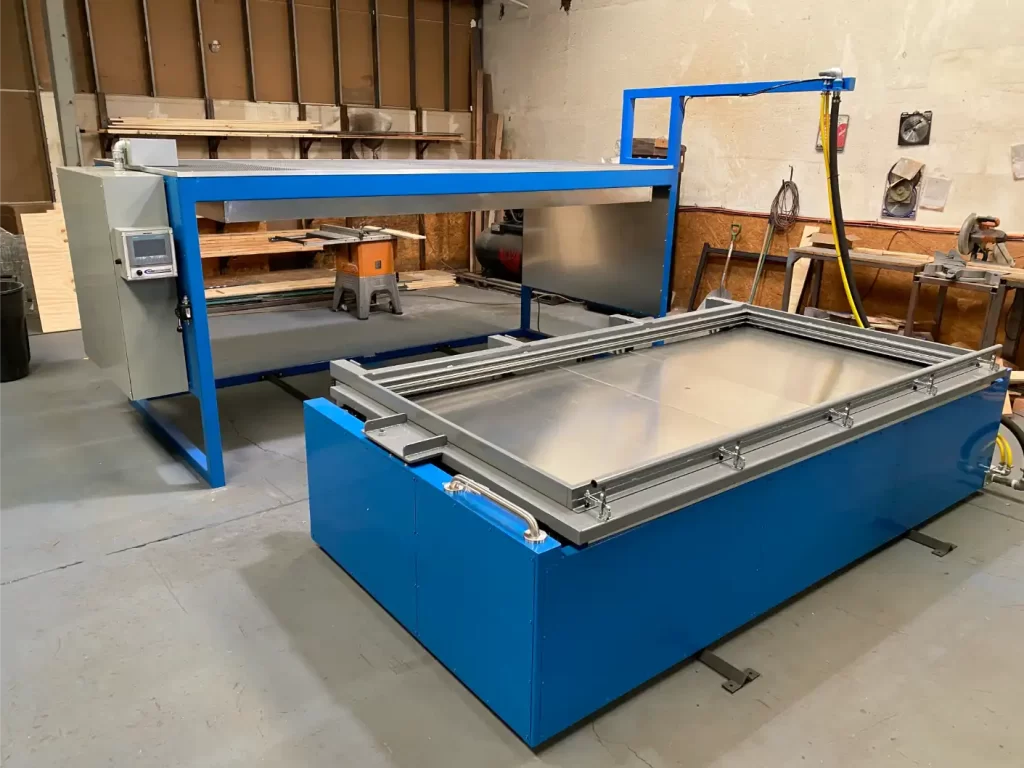Advancements in Industrial Vacuum Forming Machines
Vacuum forming, a type of thermoforming, is a manufacturing process where a plastic sheet is heated and then formed over a mold using vacuum pressure. The use of industrial vacuum forming machines has significantly evolved, with new technologies making the process more precise, efficient, and adaptable to various industries, including the aerospace industry. These machines are now capable of handling larger formats, higher material tolerances, and more intricate designs, making them ideal for creating complex aerospace components.
Key Features of Modern Vacuum Forming Machines
- Advanced PLC Control: Modern vacuum forming machines feature programmable logic controllers (PLC) for enhanced control, ensuring consistent product quality and faster production times.
- Large Format Capability: Large vacuum forming machines are now designed to accommodate the production of oversized aerospace components, such as cockpit panels and internal parts.
- Enhanced Material Compatibility: New machines can work with a wide range of materials, including specialized thermoplastics used in aerospace, such as acrylics and polycarbonates.
- Automation and Precision: Automated systems enable precise cutting and forming processes, which are crucial for the tight tolerances required in aerospace manufacturing.
Applications in Aerospace Manufacturing
The aerospace sector benefits from vacuum forming machines in a variety of ways, from prototype development to large-scale production of components. These machines are used extensively for producing lightweight yet durable parts that require precise dimensions and superior finish quality. Some common applications include:
- Cockpit Components: The creation of cockpit panels and windshields demands the highest levels of precision and material performance. Vacuum forming machines are used to create these components with lightweight materials like acrylics and polycarbonates, offering excellent visibility and durability without the weight burden of glass.
- Interior Panels and Trims: Interior parts of aircraft, such as overhead bins, door panels, and armrests, are made using vacuum forming techniques. These parts must meet stringent weight and strength requirements, and vacuum forming provides a cost-effective method for producing them in large quantities while maintaining high quality.
- Lightweight Aerospace Parts: Lightweight, high-strength materials are critical in the aerospace industry to reduce fuel consumption and improve performance. Vacuum forming is used to create lightweight structural parts like wings, tail sections, and fuselage components using specialized thermoplastics.
Revolutionizing Aerospace Design with Large-Format Vacuum Forming Machines
The demand for large vacuum forming machines has increased as aerospace manufacturers seek to produce larger components in one piece. These machines are essential for creating the large, complex shapes required in aerospace applications.
Belovac’s large-format vacuum forming machines, for instance, are specifically designed to meet these needs. With customizable options, these machines can form large, intricate components while maintaining precision and consistency. Some of the key advantages of these large-format vacuum forming machines include:
- Single-Piece Forming: The ability to form larger parts in a single piece eliminates the need for complex assembly and ensures structural integrity.
- Improved Production Efficiency: Large-format machines can handle higher-volume production runs, reducing manufacturing times and costs.
- Customization: These machines offer customization options, allowing manufacturers to tailor the forming process to meet specific aerospace design requirements.
Technology in Motion: Vacuum Forming Innovations Drive Manufacturing Advances
Recent advancements in vacuum forming technology are reshaping how the aerospace industry approaches manufacturing. These innovations are designed to improve both the quality and efficiency of the production process. Some of the key technological developments include:
- Automated Trimming and Cutting Systems: Automated trimming and cutting systems integrated into vacuum forming machines have dramatically improved the efficiency of the manufacturing process. These systems allow for precise cutting of formed components, eliminating the need for manual labor and reducing the chances of errors.
- Enhanced Heating Systems: Innovations in heating systems ensure that plastic sheets are uniformly heated before the forming process begins. This reduces material waste and ensures that the formed parts meet the high standards of quality required by the aerospace industry.
- Precision Mold Design: The development of advanced mold designs, including the use of aluminum and polyurethane tooling, enables the creation of highly detailed components with greater accuracy. These molds are essential for achieving the exact dimensions and surface finishes required in aerospace manufacturing.
Choosing the Right Vacuum Forming Machine for Aerospace Applications
Selecting the appropriate vacuum forming machine for aerospace applications requires careful consideration of factors such as part size, material compatibility, production volume, and precision requirements. The right machine must not only meet the specific needs of the aerospace components but also offer flexibility for future projects. Companies like Belovac provide a range of customizable vacuum forming machines that can cater to both small and large-scale aerospace manufacturing operations.
- Size and Format: Ensure the machine can handle the size and complexity of the parts you intend to produce, particularly when dealing with large components.
- Material Compatibility: Choose a machine that is compatible with the specialized thermoplastics used in aerospace, such as polycarbonate and acrylic.
- Production Speed: For high-volume manufacturing, select a machine with faster cycle times without compromising quality.
- Automation Features: Automated machines improve efficiency, and consistency, while reducing human error, which is critical in the aerospace sector.
Investing in the right vacuum forming machines allows aerospace manufacturers to boost production efficiency, lower operational costs, and uphold the high-quality standards required by the industry.
Partnering with Belovac for Aerospace Solutions
With over 30 years of experience, Belovac offers vacuum forming machines tailored to meet the needs of aerospace manufacturers. Our range includes entry-level models to fully automated systems, ensuring the perfect fit for your production requirements:
- Machines for all production scales: From entry-level to fully automated systems.
- Large-Format Machines: Producing complex aerospace components with precision.
- Advanced Automation: Reduces labor costs while ensuring high-quality results.
- Customizable Solutions: Tailored to specific aerospace applications.
Belovac is your trusted partner in the aerospace industry, helping you enhance operations and maintain a competitive edge.
Ready to advance your aerospace manufacturing? Contact us for a customized quote and to discuss your vacuum forming needs.


